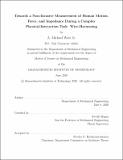| dc.contributor.advisor | Neville Hogan. | en_US |
| dc.contributor.author | West, A. Michael(Aaron Michael),Jr. | en_US |
| dc.contributor.other | Massachusetts Institute of Technology. Department of Mechanical Engineering. | en_US |
| dc.date.accessioned | 2020-09-03T17:47:40Z | |
| dc.date.available | 2020-09-03T17:47:40Z | |
| dc.date.copyright | 2020 | en_US |
| dc.date.issued | 2020 | en_US |
| dc.identifier.uri | https://hdl.handle.net/1721.1/127116 | |
| dc.description | Thesis: S.M., Massachusetts Institute of Technology, Department of Mechanical Engineering, May, 2020 | en_US |
| dc.description | Cataloged from the official PDF of thesis. | en_US |
| dc.description | Includes bibliographical references (pages 127-133). | en_US |
| dc.description.abstract | Despite inferior 'wetware' and 'hardware', humans out-perform robots in tasks that require physical interaction, especially physical interaction with non-rigid objects. This performance gap is ever-present in the manufacturing process known as wire-harnessing. Generally, on an assembly line, robots can be used to quickly and accurately assemble a system. However, due to the non-rigid nature of a wire harness, wire-harnessing is done manually. In an effort to better inform robots to help humans do this task, it was proposed to study how humans install wire-harnesses. However, current methods of studying human behavior inherently impede the human. Thus, it was proposed to develop a method that can measure the force and impedance of a wire-harness installation worker's hands and arms using solely motion information. To do so for the human hand, the idea of using a whole-hand, synergy-based Interaction Capture method was explored. | en_US |
| dc.description.abstract | However, current knowledge of synergies has not yet been extended beyond reach and grasp to object manipulation. Upon trying to compare synergies during wire-harness installation and object reach-and-grasp, it was found that only the first synergy is common. In arm motion, it has been previously found that humans can estimate joint stiffness using purely visual observation of kinematic motion. However, it was unclear which motion characteristics subjects used to determine their stiffness estimates. To explore this, new simulations were produced using modified velocity profiles. The results suggested that path, not trajectory, information is more important to subjects when estimating stiffness. | en_US |
| dc.description.abstract | Furthermore, upon training a machine to do this task, using supervised linear regression, it was found that the better performing linear classifiers had a higher emphasis on position values as opposed to velocity and acceleration, which reinforces the conclusion that path information dominates trajectory information in the visual perception of stiffness. Given stiffness estimates, using kinematic hand synergies and visual perception of arm stiffness, the challenge of estimating contact force in a high degree-of-freedom space still remains. MuJoCo was tested and validated as a viable tool for estimating contact forces in multi-joint dynamics, allowing one to accurately obtain force information. While the ability to monitor a human's motion, force, and impedance during wire-harness installation was not achieved, this thesis provides essential insight into how to create a system | en_US |
| dc.description.statementofresponsibility | by A. Michael West Jr. | en_US |
| dc.format.extent | 133 pages | en_US |
| dc.language.iso | eng | en_US |
| dc.publisher | Massachusetts Institute of Technology | en_US |
| dc.rights | MIT theses may be protected by copyright. Please reuse MIT thesis content according to the MIT Libraries Permissions Policy, which is available through the URL provided. | en_US |
| dc.rights.uri | http://dspace.mit.edu/handle/1721.1/7582 | en_US |
| dc.subject | Mechanical Engineering. | en_US |
| dc.title | Towards a non-invasive measurement of human motion, force, and impedance during a complex physical-interaction task : wire-harnessing | en_US |
| dc.type | Thesis | en_US |
| dc.description.degree | S.M. | en_US |
| dc.contributor.department | Massachusetts Institute of Technology. Department of Mechanical Engineering | en_US |
| dc.identifier.oclc | 1191836251 | en_US |
| dc.description.collection | S.M. Massachusetts Institute of Technology, Department of Mechanical Engineering | en_US |
| dspace.imported | 2020-09-03T17:47:40Z | en_US |
| mit.thesis.degree | Master | en_US |
| mit.thesis.department | MechE | en_US |
